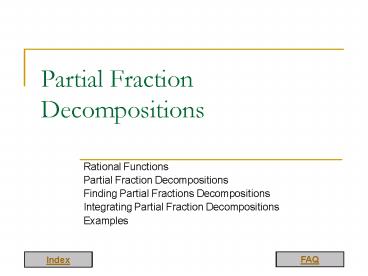Partial Fraction Decompositions - PowerPoint PPT Presentation
1 / 21
Title:
Partial Fraction Decompositions
Description:
General partial fraction decomposition is technically complicated and involves several cases. ... of the partial factor decomposition depends on the type of ... – PowerPoint PPT presentation
Number of Views:1720
Avg rating:3.0/5.0
Title: Partial Fraction Decompositions
1
Partial Fraction Decompositions
- Rational Functions
- Partial Fraction Decompositions
- Finding Partial Fractions Decompositions
- Integrating Partial Fraction Decompositions
- Examples
2
Rational Functions
A function of the type P/Q, where both P and
Q are polynomials, is a rational function.
Definition
Example
The degree of the denominator of the above
rational function is less than the degree of the
numerator. Hence we may rewrite the above
rational function in a simpler form by performing
polynomial division.
Rewriting
For integration, it is always necessary to
perform polynomial division first, if possible.
To integrate the polynomial part is easy, and one
can reduce the problem of integrating a general
rational function to a problem of integrating a
rational function whose denominator has degree
greater than that of the numerator.
3
Example of Integrating Rational Functions
Here K is the constant of integration.
4
Partial Fraction Decomposition (1)
of the function to be integrated.
Definition
The above decomposition of the rational function
(3x23x2)/(x3x2x1) is a partial fraction
decomposition.
Partial Fraction Decomposition is a rewriting of
a rational function into a sum a rational
functions with as simple denominators as possible.
General partial fraction decomposition is
technically complicated and involves several
cases. It all starts with a factorization of the
denominator. The type of the partial factor
decomposition depends on the type of the factors
of the denominator. The different cases will be
explained on the following slides.
5
Partial Fraction Decompositions (2)
The partial fraction decomposition of a rational
function RP/Q, with deg(P) lt deg(Q), depends
on the factors of the denominator Q. Since we
are factoring over real numbers, the denominator
Q may have following types of factors
- Simple, non-repeated linear factors ax b.
- Repeated linear factors of the form (ax b)k, k
gt 1. - Simple, non-repeated quadratic factors of the
type ax2 bx c. Since we assume that these
factors cannot anymore be factorized, we have
b2 4 ac lt 0. - Repeated quadratic factors (ax2 bx c)k, kgt1.
Also in this case we have b2 4 ac lt 0.
Finding the partial fraction decompositions is,
in all of the above cases, same type of
computation. Eventually one wants to integrate
the resulting partial fraction decomposition.
The integration can, in all cases, be based on
formulae, but the computations will get
technically complicated.
6
Simple Linear Factors (1)
Case I
Partial Fraction Decomposition Case I
7
Simple Linear Factors (2)
Example
8
Simple Quadratic Factors (1)
Case II
Partial Fraction Decomposition Case II
9
Simple Quadratic Factors (2)
Example
10
Repeated Linear Factors (1)
Case III
Partial Fraction Decomposition Case III
11
Repeated Linear Factors (2)
Example
12
Repeated Quadratic Factors (1)
Case IV
Partial Fraction Decomposition Case IV
13
Repeated Quadratic Factors (2)
Example
This can also be computed by Maple command
convert.
14
Integrating Partial Fraction Decompositions (1)
Partial Fraction Decomposition is the main method
to integrate rational functions. After a general
partial fraction decomposition one has to deal
with integrals of the following types. There are
four cases. Two first cases are easy.
Here K is the constant of integration.
15
Integrating Partial Fraction Decompositions (2)
In the remaining cases we have to compute
integrals of the type
In the case 3, observe that since the
denominator cannot be factored further we have
4ac-b2 gt 0. By suitable rewritings and
substitutions we get
Here K denotes the constant of integration.
16
Integrating Partial Fraction Decompositions (3)
By repeated integrations by parts these integrals
can eventually be computed by the formula for the
integrals of type 3.
Theorem
17
Integration Algorithm
- Integration of a rational function f P/Q,
where P and Q are polynomials can be
performed as follows. - If deg(Q) ? deg(P), perform polynomial division
and write P/Q S R/Q, where S and R are
polynomials with deg(R) lt deg(Q).Integrate the
polynomial S. - Factorize the polynomials Q and R. Cancel the
common factors. Perform Partial Fraction
Decomposition to the simplified form of R/Q. - Integrate the Partial Fraction Decomposition.
18
Examples (1)
Example 1
19
Examples (2)
Example 1 (contd)
Substitute ux2x1 in the first remaining
integral and rewrite the last integral.
20
Examples (3)
Example 2
We can simplify the function to be integrated by
performing polynomial division first. This needs
to be done whenever possible. We get
Partial fraction decomposition for the remaining
rational expression leads to
Now we can integrate
21
Examples (4)
Example 3
Partial fraction decomposition in this case yields
This is easy to integrate.
It is, however, easier to observe that the
substitution
Leads to the result immediately

